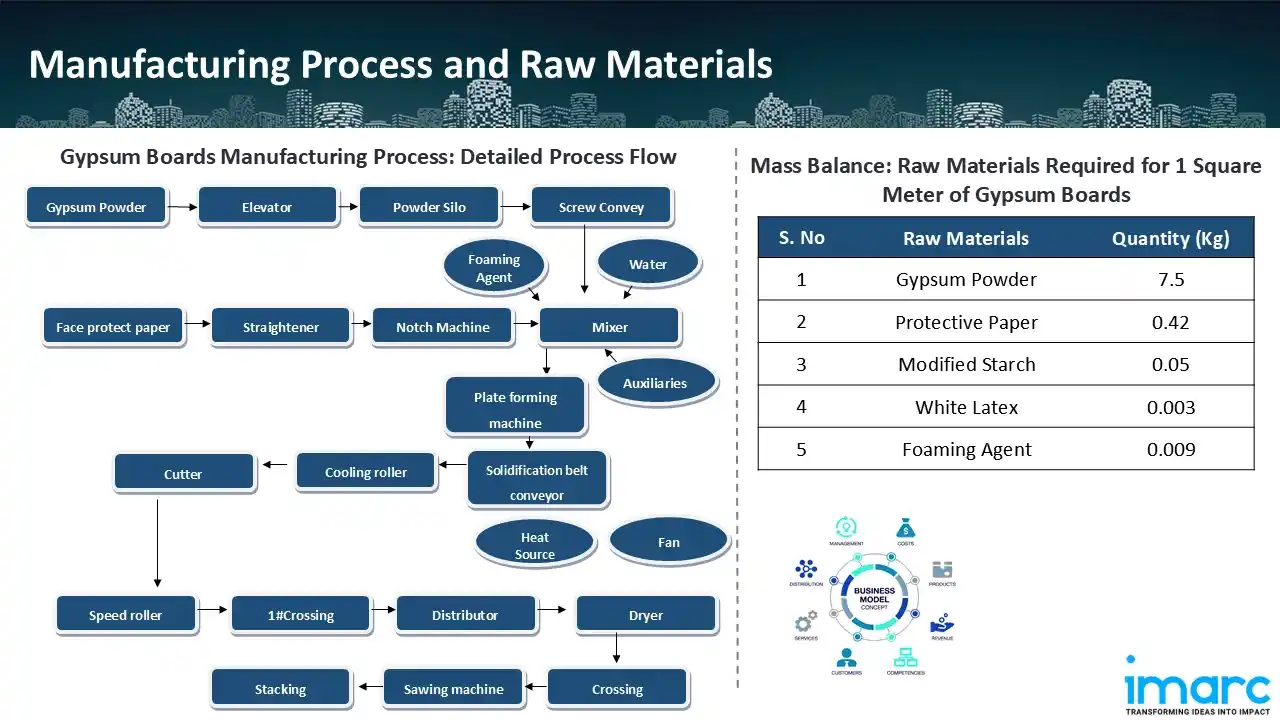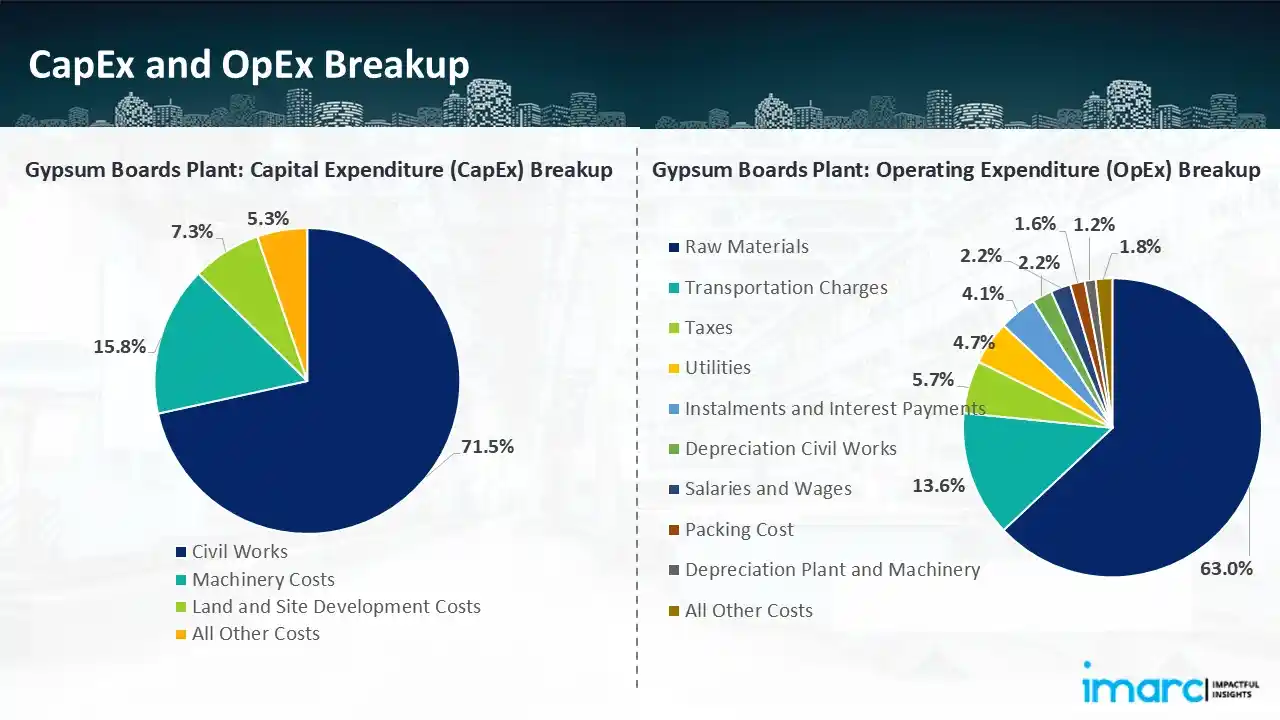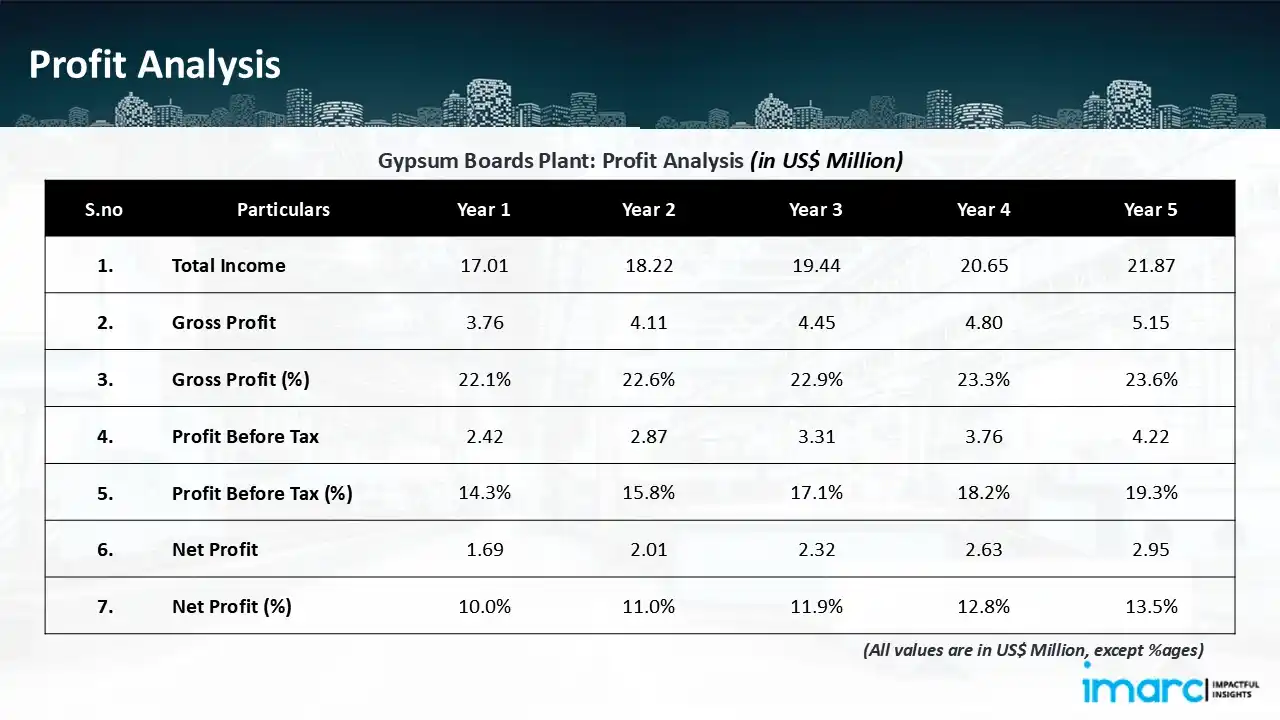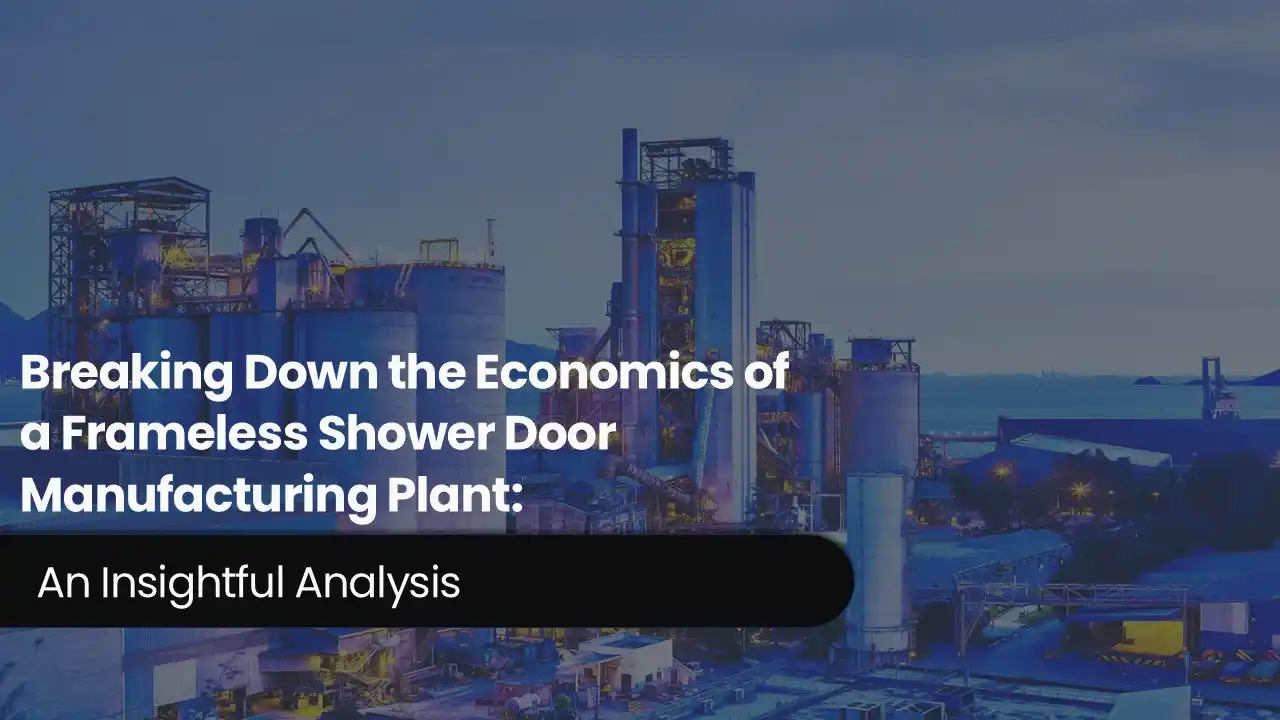Investment and Cost Structure of Gypsum Boards Manufacturing Plant: A Cost Model Approach
_11zon.webp)
Gypsum boards, also referred to as drywall or plasterboard, are lightweight, strong and fireproof building materials that are frequently used for partitions, walls and ceilings. Constructed from a gypsum core encased in paper liners, they provide improved acoustics, cost effectiveness, and speedy installation. Gypsum boards are favoured in industrial, commercial, and residential construction because of its environmentally beneficial qualities, ability to withstand moisture, and ability to insulate against heat. They are an essential part of efficient and sustainable construction methods because of their adaptability to contemporary building processes. According to an IMARC study, the global gypsum boards market size reached USD 31.7 Billion in 2024. Looking ahead, the market is expected to grow at a CAGR of approximately 4.7% from 2025 to 2033, reaching a projected size of USD 47.9 Billion by 2033. Rapid infrastructure development, urbanisation, and the rising need for fire-resistant, long-lasting, and lightweight building materials are the main factors propelling the gypsum board market. Demand is fuelled by the growing number of residential, commercial, and industrial structures being built, particularly in emerging economies. Government programs that support smart cities and affordable housing also increase the use of gypsum board. Another important factor is the move to more environmentally friendly building materials since gypsum boards are recyclable and provide insulation that uses less electricity. Due to its quicker installation and lower cost, plasterboard systems are becoming more and more popular than traditional plastering, which propels market expansion. Moreover, the growth of the corporate sector, healthcare, and hospitality industries raises demand for aesthetically pleasing and acoustically friendly interior solutions, where gypsum boards are frequently utilised. Technological developments like fire-rated and moisture-resistant gypsum boards also help the market grow. The industry's growth prospects are further strengthened by consumers' growing desire for green and eco-friendly building materials.
Trending Insights on Gypsum Boards: Latest News and Developments
- In November 2024, Gyptech, a Canadian manufacturer that specialises in gypsum and asphalt shingle equipment, was purchased by Fortress Investment Group. It is anticipated that this calculated action will support Gyptech's international growth and technological advancement in the gypsum board industry.
- In January 2024, gypsum wallboard imports from China and Oman are now subject to additional taxes imposed by the Indian government. For Chinese gypsum wallboard, importers will pay between USD 23.46 and USD 47.62/t, while for Omani gypsum wallboard, they would pay between US$71.80 and US$91.42/t.
- In December 2023, Saint-Gobain Gyproc unveiled a variety of cutting-edge gypsum wallboards, such as "Habito Standard" for heavily loaded applications, "Rigiroc," a multifunctional moisture-resistant board, and "Glasroc X," an external wallboard made to improve performance and durability in a range of construction settings.
- In October 2023, Georgia-Pacific's new gypsum wallboard facility in Sweetwater, Texas, has formally opened. The project, which cost USD 325 Million, was Georgia-Pacific's first new wallboard plant since 2004.
- In April 2023, Sakarni and Gypskarton have teamed up to produce gypsum boards in India. The goal of this partnership is to decrease reliance on imports and increase domestic production. It is anticipated that the collaboration will increase accessibility, raise standards of quality, and assist India's expanding building industry.
Case Study on Cost Model of Gypsum Boards Manufacturing Plant
Objective: One of our clients has approached us to conduct a feasibility study for establishing a mid to large-scale gypsum boards manufacturing plant in Nigeria. We have developed a detailed financial model for the plant's setup and operations. The proposed facility is designed with an annual production capacity of 15,000,000 square meter of gypsum boards and will cover a land area of 15,000 square meter.
Manufacturing Process: The first step in making gypsum boards is stock preparation, which involves removing, moving, crushing, and turning raw gypsum into calcined powder. In a slurry tank, this powder is subsequently combined with additional ingredients for processing, such as acetic acid resin, modified starch, and a foaming agent. The foaming agent is added initially to make the board lightweight after the gypsum powder and water have formed a slurry during the ingredients mixing step. A belt measurement system that is automated is used to combine additional chemicals. In order to create a board, the slurry is poured onto one sheet of protecting paper and then covered with another, creating a "sandwich." Moulding machines enhance the board's appearance, while forming plates define its thickness. As the board travels along a conveyor during the board line and cutting step, it solidifies. After being chopped to the proper sizes by a blade, it goes through a drying process that eliminates moisture in about an hour. Lastly, boards are taped, cut, and stacked for shipping in edge binding and stacking.

Mass Balance and Raw Material Required: The primary raw materials utilized in the gypsum boards manufacturing plant include gypsum powder, protective paper, modified starch, white latex and foaming agent. To produce 1 square meter of gypsum board, we require 7.5 kg of gypsum powder, 0.42 kg of protective paper, 0.05 kg of modified starch, 0.003 kg of white latex, and 0.009 kg of foaming agent.
List of Machinery:
The following equipment was required for the proposed plant:
- Unwinding Unit (Up and Down Paper Rack)
- Pulling-off Unit
- Deviation Rectifying Machine
- Grooving Machine
- Vibrating Table
- Mixer
- Board Forming Machine
- Transitional Roller
- Pulp Putting System
- Solidification Belt Conveyor
- Conveying Roller
- Double SERVO Cutter
- Speed-up Roller Conveyor
- Waste Board Belt Conveyor
- Transversal Machine
- Distributor
- Dryer
- Board Out Machine
- Transitional Roller Bed After Board Out
- Transversal Machine
- Transitional Belt Machine After Transversal
- Board Closing Machine
- Discharge Roller Bed After Transversal
- Edge Trimmer (With Auto Edge Sealing Machine)
- Board Throwing Machin1 Belt Conveyor to Stacker Table
- Belt Conveyor to stacker table
- Auto Stacker (With Hydralic Lifting Table)
- Edge Trimming Dust Suction Device
- Passing Bridge, Platform etc. Non-standard Making
- Electric Control Cabinet
- Combustion Mode
Techno-Commercial Parameter:
- Capital Investment (CapEx): The total capital cost for establishing the proposed gypsum boards manufacturing plant is approximately USD 11.69 Million. Civil works cost account for 71.5% of the total capital cost, while machinery costs are estimated at around USD 1.85 Million. The land and site development cost for gypsum boards manufacturing plant constitutes a significant portion of the total capital cost, including the land registration charges, development charges of boundary walls, steel gates and other developmental charges. This ensures a robust foundation for safe and efficient plant operations.
- Operating Expenditure (OpEx): In gypsum boards manufacturing plant, the operating cost for the first year of operations is projected at USD 13.24 Million. This estimate includes the cost of raw materials, utilities, depreciation, taxes, packing cost, transportation cost, and repairs and maintenance. By the fifth year of operations, the total operational cost is expected to increase by 26.2% compared to the first year, driven by inflation, market fluctuations, and potential rises in the cost of key materials. Disruptions to the supply chain, rising consumer demand, and shifts in the state of the world economy are some of the factors causing this growth.

- Profitability Analysis Year on Year Basis: The proposed gypsum boards plant, with a capacity of 15,000,000 square meter of gypsum boards annually, achieved an impressive revenue of USD 17.01 Million in its first year. We assisted our client in developing a detailed cost model, which projects steady growth, with revenue reaching USD 21.87 Million by year 5. Gross profit margins improve from 22.1% to 23.6%, and net profit margins rise from 10.0% to 13.5%, highlighting strong financial viability and operational efficiency.

Conclusion
Our gypsum boards manufacturing plant's financial model was meticulously modelled to satisfy the client's requirements. It provided a thorough analysis of production costs including capital expenditures, manufacturing processes, raw materials, and operating costs. The model predicts profitability while accounting for market trends, inflation, and any shifts in the price of raw materials. It was created especially to satisfy the demand of producing 15,000,000 square meter of gypsum boards annually. Our commitment to offering precise, client-cantered solutions that ensure the long-term success of significant industrial projects by giving the client useful data for strategic decision-making is demonstrated by this comprehensive financial model.
IMARC's Financial Model Expertise: Helping Our Clients Explore Industry Economics
IMARC is a global market research company that offers a wide range of services, including market entry and expansion, market entry and opportunity assessment, competitive intelligence and benchmarking, procurement research, pricing and cost research, regulatory approvals and licensing, factory setup, factory auditing, company incorporation, incubation services, recruitment services, and marketing and sales.
Brief List of Our Services: Market Entry and Expansion
- Market Entry and Opportunity Assessment
- Competitive Intelligence and Benchmarking
- Procurement Research
- Pricing and Cost Research
- Sourcing
- Distribution Partner Identification
- Contract Manufacturer Identification
- Regulatory Approvals, and Licensing
- Factory Setup
- Factory Auditing
- Company Incorporation
- Incubation Services
- Recruitment Services
- Marketing and Sales
Under our factory setup services, we assist our clients in exploring the feasibility of their plants by providing comprehensive financial modeling. Additionally, we offer end-to-end consultation for setting up a plant in India or abroad. Our financial modeling includes an analysis of capital expenditure (CapEx) required to establish the manufacturing facility, covering costs such as land acquisition, building infrastructure, purchasing high-tech production equipment, and installation. Furthermore, the layout and design of the factory significantly influence operational efficiency, energy consumption, and labor productivity, all of which impact long-term operational expenditure (OpEx). So, every parameter is covered in the analysis.
At IMARC, we leverage our comprehensive market research expertise to support companies in every aspect of their business journey, from market entry and expansion to operational efficiency and innovation. By integrating our factory setup services with our deep knowledge of industry dynamics, we empower our clients to not only establish manufacturing facilities but also strategically position themselves in highly competitive markets. Our financial modeling and end-to-end consultation services ensure that clients can explore the feasibility of their plant setups while also gaining insights into competitors' strategies, technological advancements, and regulatory landscapes. This holistic approach enables our clients to make informed decisions, optimize their operations, and align with sustainable practices, ultimately driving long-term success and growth.
Contact Us
Have a question or need assistance? Please complete the form with your inquiry or reach out by emailing us on sales@imarcgroup.com.
